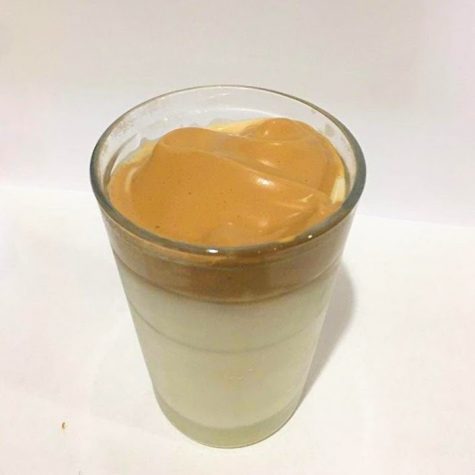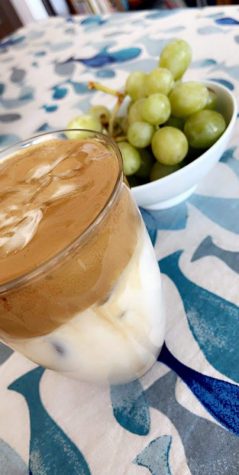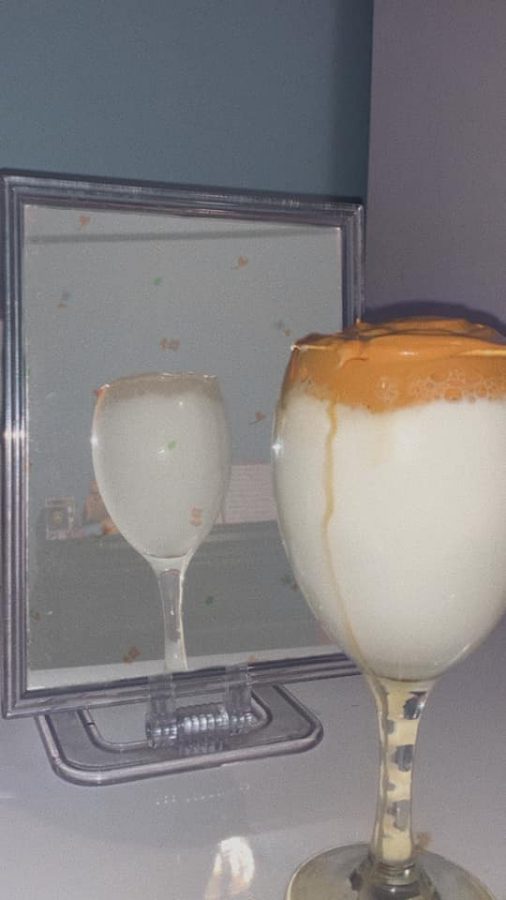Whipping Up Coffee During Quarantine
Lights, camera, action! Some people are taking the whipped coffee trend to another level by using photography to portray various aesthetics and messages.

Once the instant coffee mix is whipped into a fluffy texture, make sure to layer it carefully onto the milk. This helps create the dynamic contrast between the coffee and the milk.
As Americans across the country continue to shelter in at home during the Coronavirus pandemic, many students have found hobbies and interests to overcome their newfound boredom. For teenager Hannah Cho, this meant posting a short fifteen- second video on social media platform TikTok in early March 2020, which showed her making a simple drink. However, it was not any ordinary drink; it was whipped coffee, also known as “dalgona coffee” in South Korea. A few million views later, whipped coffee has skyrocketed to become a favorite quarantine beverage. Cho’s viral video has also led other users on the platform to share their own takes on whipped coffee, such as whipped Nesquik, matcha, and more. For some Bronx Science students, whipped coffee has become their new favorite drink to make.
To understand how whipped coffee became so trendy, we must first trace it back to where it all started. Before Cho’s TikTok video, whipped coffee was already popular in South Korea. However, the version of whipped coffee that we know today originated from Macau. Through the popular South Korean television show, ‘Stars’ Top Recipe at Fun-staurant,’ actor Il-woo Jung tried the drink and said that it reminded him of the South Korean dessert called dalgona. Soon enough the Macanese drink became known as dalgona coffee, seen in Cho’s TikTok video.
With the power of a simple high-quality phone camera, aesthetic background music, and quick cuts, the TikTok algorithm pushed Cho’s video to the “For You” page of users across the platform. The algorithm, aided by the young demographic of TikTok with newfound free time, helped to spread the whipped coffee phenomenon across borders into Western countries such as the United States and the United Kingdom.
In times where grocery shopping is limited, the coffee concoction, which consists of ingredients that nearly all households have (instant coffee, table sugar, hot water, and milk), became an overnight sensation.
“I think its popularity comes from the fact that it requires a few common ingredients and creates such a visually appealing drink, providing the fun we need despite the restriction of not being able to buy ingredients on a whim like we could before,” said Ulises Ponce ’23.
However, not everyone thinks that whipped coffee is worth the hype that it is getting. In fact, many people initially struggle to correctly whip the coffee into its frothy, cloud-like texture. Using a traditional whisk or kitchen utensil can take up to an hour for the coffee to set. “You should try to use an electric whisk or a drink frother if you can!” advises Reese Villazor ’21.

For many people, whipped coffee tastes better when it is served cold. Add in a few ice cubes, and you will get iced whipped coffee!
For some, the tedious process of making whipped coffee makes the end product feel lackluster at best. “At first, I thought it was cute because it was pretty, but honestly it’s not worth the hype. I don’t like the taste of instant coffee and, as other people said, it’s way too concentrated and sugary. Also, it’s kind of messy and difficult to drink with milk because it’s a completely different texture,” said Juliet Daniel ’21. Other students at Bronx Science shared similar feelings of discontent. “I tried making it, and it was not worth it. It took too much time for a really underwhelming drink that was too sweet,” said Arielle Bartoli ’21.
In an age where internet trends come and go, it seems like whipped coffee is here to stay. While the drink might not be to everyone’s taste, there is no doubt that it has impacted the way many people go about their daily routines. Whether one makes it just for fun, incorporates it into your everyday morning routine, or just trys it out to see if it is truly worth the hype, it seems like everyone is whipping up coffee during quarantine.
“I think its popularity comes from the fact that it requires a few common ingredients and creates such a visually appealing drink, providing the fun we need despite the restriction of not being able to buy ingredients on a whim like we could before,” said Ulises Ponce ’23.
Kin Yang is a Staff Reporter for the ‘Science Survey.’ He finds that journalistic writing is an important way to explore and learn about new subject...
Ellie Michaud is a Graphic Designer for ‘The Observatory.’ As a graphic designer, she is involved in creating unique and interesting spreads for ‘The...

